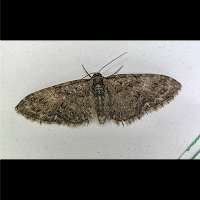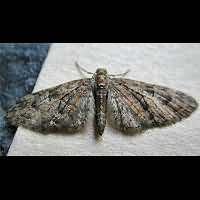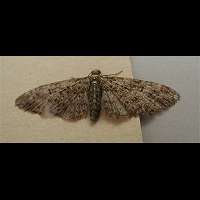Brindled Pug Eupithecia abbreviata
The first Brindled Pugs appear in March. These are easily identified, for there are no other pugs around this early in the year. But from April other species make their appearance and identifying a Brindled Pug becomes more difficult. One of the characteritics of the Brindled Pug often is the reddish or ocherous brown colour of the vein running parallel to the underedge of the frontwing. The dot in the front wing, common in almost all pugs, is extremely small and absent at times. Often a white wavy line can be seen near the edge of the front wing. The Oak-tree Pug looks like the Brindled a lot, but has a much larger and clearer black spot in the wing. Besides: the Oak-tree Pug looks smaller, has more distinct markings, is rarer and doesn't start flying till half April. The Brindled Pug also comes in melanistic forms regularly. These can only be identified by the shape of the wings. The Brindled Pug reaches a wingspan of some 19 to 23 mm.
The eggs are being laid in April and May. The females prefer young bushy oaks or the lower branches of older trees to do so. The caterpillars are brown with a black line on the back. They are undistinguishable from the larvae of the Oak-tree Pug. In september the caterpillar looks for a crack in the bark of the tree or loose earth, where it makes a cocoon in which it pupates. It overwinters as a pupa. Even though sometimes found on other oaks and Hawthorn, the main foodplant is Pedunculate Oak.
The Brindled Pug is single-brooded, but is on the wing for a relatively long period of time: from half March to the end of May. The greatest numbers however are seen in the second half of April and the beginning of May. Comes to light easily and can also be seen flying in early dusk. The moth doesn't like single oak trees, but prefers rather vast oak forests. When it appears it is usually in great numbers. Common all over Britain and Ireland, except in the Scottish Highlands.
The first Brindled Pugs appear in March. These are easily identified, for there are no other pugs around this early in the year. But from April other species make their appearance and identifying a Brindled Pug becomes more difficult. One of the characteritics of the Brindled Pug often is the reddish or ocherous brown colour of the vein running parallel to the underedge of the frontwing. The dot in the front wing, common in almost all pugs, is extremely small and absent at times. Often a white wavy line can be seen near the edge of the front wing. The Oak-tree Pug looks like the Brindled a lot, but has a much larger and clearer black spot in the wing. Besides: the Oak-tree Pug looks smaller, has more distinct markings, is rarer and doesn't start flying till half April. The Brindled Pug also comes in melanistic forms regularly. These can only be identified by the shape of the wings. The Brindled Pug reaches a wingspan of some 19 to 23 mm.
The eggs are being laid in April and May. The females prefer young bushy oaks or the lower branches of older trees to do so. The caterpillars are brown with a black line on the back. They are undistinguishable from the larvae of the Oak-tree Pug. In september the caterpillar looks for a crack in the bark of the tree or loose earth, where it makes a cocoon in which it pupates. It overwinters as a pupa. Even though sometimes found on other oaks and Hawthorn, the main foodplant is Pedunculate Oak.
The Brindled Pug is single-brooded, but is on the wing for a relatively long period of time: from half March to the end of May. The greatest numbers however are seen in the second half of April and the beginning of May. Comes to light easily and can also be seen flying in early dusk. The moth doesn't like single oak trees, but prefers rather vast oak forests. When it appears it is usually in great numbers. Common all over Britain and Ireland, except in the Scottish Highlands.









